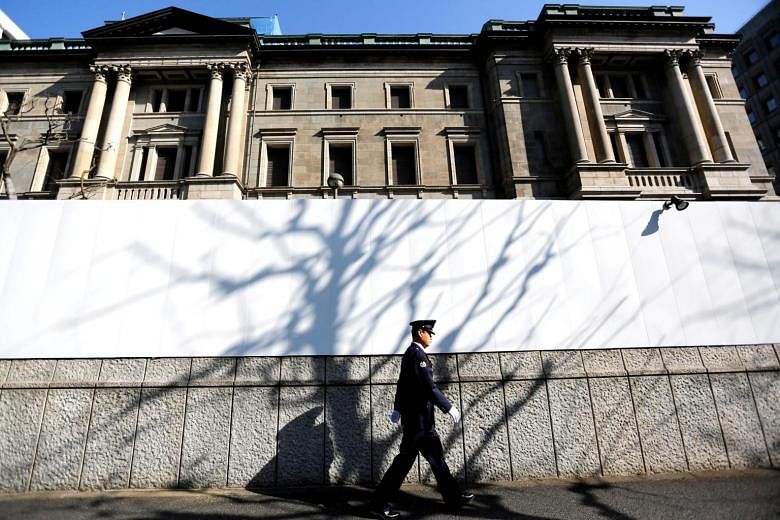TOKYO (BLOOMBERG) - The Bank of Japan left rates unchanged on Tuesday (Jan 21) and painted a brighter picture of the economic outlook, offering a further indication that the likelihood of additional stimulus has receded.
The central bank maintained its targets for interest rates and asset purchases, an outcome forecast by all 42 economists surveyed by Bloomberg. The BOJ also raised its growth projections for the first time in a year, as had been widely expected, thanks to Prime Minister Shinzo Abe's US$120 billion (S$161.6 billion) economic package unveiled last month.
The stand-pat decision came ahead of meetings by the European Central Bank and the Federal Reserve this week and next. The gatherings kick off a year that is likely to see all three central banks sticking to a holding pattern for the time being amid signs the global economy is past the worst of a slowdown.
Since the BOJ's previous meeting in December, the US and China have signed off on a phase one trade deal removing for now one of the biggest uncertainties on the horizon for the economic outlook. The yen has also weakened against the dollar, falling to eight-month lows after a short-lived surge at the start of January.
The central bank said that while overseas risks to the economy remained significant, they had decreased somewhat. It said it wouldn't hesitate to take additional easing action if risks increased. Economists noted that while the growth forecasts were nudged up, the inflation outlook still remains weak.
"The BOJ is trying to avoid sending a message that it's getting confident about the economy or it's starting to seek adjustments to its easing bias," said Nobuyasu Atago, chief economist at Okasan Securities and former head of the BOJ's price statistics division. "The bottom line is that the BOJ is comfortable with the current yen level and it doesn't want to change that by indicating optimism or change in its cautious view."
While Japan's economy is expected to have contracted sharply in the last three months of 2019 following a destructive super typhoon and a sales tax hike that cooled spending, the trajectory for this year now looks less gloomy. A slump in overseas demand may have bottomed and the Abe administration's stimulus is set to give the economy a shot in the arm.
The fiscal injection looks sufficient to help get growth back on track this year and remove the need for additional action by a central bank already stretched close to the limits of its policy toolkit and facing mounting costs of its easing program. The BOJ now projects the economy to expand 0.9 per cent in the year starting in April, compared with a 0.7 per cent forecast in October, citing the impact of the government's measures.
DEFLATION DODGED
Abe has also aided the BOJ's position by playing down the significance of continued feebleness in price growth. While movements in inflation were previously seen as potential triggers for policy action, government pressure on the central bank to achieve its 2 per cent price goal has dissipated considerably. The prime minister didn't even mention deflation in his inaugural speech at the start of this year's parliamentary session on Monday.
Abe has likely calculated that calling for higher inflation risks a public backlash after the government forced up prices with the sales tax increase in October.
As the year progresses the focus is likely to shift to when the BOJ will step back from its tilted bias toward easing to a more neutral stance, assuming no events derail the recovery. The change in guidance would be a necessary move toward contemplating an eventual normalization of policy. Most economists surveyed by Bloomberg now expect the bank's next move to be in the direction of tightening, though the likely horizon for that would be next year.
If the global economic bottoming continues, the BOJ may be able to reverse its easing tilt, but that depends on how the Fed moves first, and whether reversing its stance would affect the yen significantly, said Yuichi Kodama, chief economist at Meiji Yasuda Life Insurance.
The BOJ's upgraded growth forecasts position it between the view of private economists and the more optimistic projections of the government. Economists predict economic growth of only 0.6 per cent in fiscal 2020, the year starting in April, while the government expects an expansion of 1.4 per cent.
"If you take a step back, they are forecasting inflation of only 1.4 per cent even in fiscal 2021. That's very weak after years of massive easing and I think it's coming to a stage where they need to rethink the price target. I wouldn't be surprised if that discussion takes place this year as the Fed and ECB are also discussing theirs," Atago said.

